VARIETIES OF VEGETABLE CROPS
| VARIETY |
DESCRIPTION |
| 1. Amaranthus |
 |
CO 1 (1968) |
|
It is a selection from a type collected from Tirunelveli (Amaranthus dubius Mart exThell.). It is suitable for growing for tender greens (Mulaikeerai) and immature stems (Thandukkeerai) which are thick and fleshy. The crop duration is 25 days for mulaikeerai and 50-60 days for thandukeerai. It yields 78 tonnes of greens per hectare at 25 days after sowing. The leaves are broad, thick and dark green in colour. The seeds are very small and black. |
 |
CO 2 (1979) |
|
It is a selection from a germplasm type of Thanjavur, A. tricolor L.(syn. A gangeticus), with a duration of 25 days for mulaikeerai and 35-50 days for thandukeeari. It yields 10.75 tonnes/ha of greens. Seeds are black, bold and exhibit early germination with vigorous growth. The plants are erect with moderate branching. The crude fibre content is less (1.3%) with 19.0 mg of iron and 20.0 mg of calcium per 100g. |
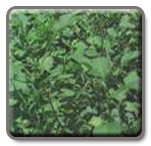 |
CO 3 (1988) |
|
It is a selection from the local type and yields 30.72 tonnes of greens per hectare. It is a clipping type (A. tristis ). It is called Arakkeerai or Killukeerai in Tamil. It lends itself for 10 clippings, commencing from 20 days after sowing and provides a continuous supply of luscious tender green for three months. The leaf to stem ratio is high (2.0). The plants are erect with green nutritious leaves containing 25.2 mg per 100g of vitamin C, 1.74% crude fibre, 0.8% iron and 2.48% Ca. The seeds are black in color. |
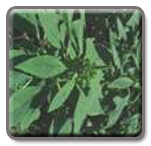 |
CO 4 Grain type(1989) |
|
It is a green cum grain type from A. hypochondriacus L., which is suitable for growing in plains and hills throughout Tamil Nadu. It yields 2,555kg/ha of grain in addition 8,200 kg/ha of leaves on 25th day after thinning in a spacing of 30 x 30 cm. The crop duration is 90 days. The seeds are rich in protein (15.95%) and essential amino acids like lysine (7.5 mg/100g), phenylalanine (5 mg/100g), leucine (1.2 mg/100g) and isoleucine (1.8 mg/100g). The grain can be substituted for minor millets like ragi and thenai. It is amenable for various food preparations like any other grains. |
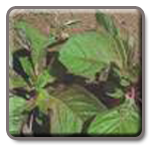 |
CO 5 (1998) |
|
It is a single plant selection from germplasm (A 166-1) with a duration of 50 days. It is released from the Horticultural College and Research Institute, Coimbatore. The crop performs well during June-September and January-May. This variety has a leaf yield of 40 t/ha, which is 47% more over CO.1, and 300% more over CO.2. The crop is adapted to entire state of Tamil Nadu. The plants are medium in height with high biomass and nutritive value. The stem and petiole are pinkish red in color. The leaves are large obovate. It is also ideal for patio or container cultivation. The crop can be harvested at 30 days for mulaikeerai (10 t/ha) and at 50 days for thandukeerai (30 t/h). |
| Top |
| 2. Annual moringa |
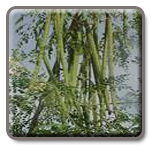 |
PKM 1 (1989) |
|
It is a pureline selection from the population generated by continuous selfing of seed moringa type collected from Eppodumvendran of Tirunelveli district for six generations. In each generation, only the plants with long pod with desirable attributes were selected and advanced. The fruits are long, fleshy and tasty. It comes to bearing in six months after sowing. The peak harvest is during March to August. The plants grow to a height of about 4-6 meters in a year with 6-12 primary branches. The pinnate leaves are about 40 cm long with small leaflets, which are dark green on the upper side and pale green in the lower side. Though flowers are in clusters (25-150/cluster), only one pod develops per cluster usually. Occasionally 2 to 4 pods are seen in a cluster. The pods are 70 cm long, 6.3 cm in girth and weigh about 150g. The average yield per tree per year is 218 pods weighing about 35kg. The estimated yield per hectare is 52.8 tonnes. The pods attain edible maturity in 65 days after flowering. The leaves can be used as nutritive greens. Ratoon crops can be taken for 3-4 years. After every year the trees have to be cut back to about one meter from ground level. This variety can be grown as an intercrop in orchards and coconut gardens during the pre-bearing period. Chillies, onion and groundnut can be grown as intercrops in annual moringa. |
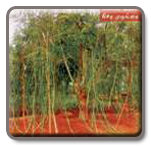 |
PKM 2 (2000) |
|
It is a hybrid derivative developed by cross between MP31 (Eppodumvendran local) X MP28 (Arasaradi local) at Horticultural College and Research Institute, Periyakulam. It can be easily propagated through seeds. September-October is ideal season for this variety. The tree comes to bearing in six months and suitable for growing in different cropping systems and home garden. The pods are 125.2 cm long with 8.3 cm girth, weighing 280 g. Pods are less seeded, more fleshy and delicious. The average number of fruits is 220/ tree/year, which is 9.18% higher over PKM.1, and weighs 61.65 kg/tree, which is 71.5 over PKM.1. It yields 98 t/ha under irrigated condition. Ratoon crops can also be taken for three years. Suitable for growing in plains of Tamil Nadu. Adapted to most soil types ranging from sandy loam to clay loam with good drainage. |
| Top |
| 3. Ash gourd |
CO 1 (1971) |
It is a selection from a local type from Tamil Nadu with crop duration of 150 days. It yields 20-25 t/ha with good cooking quality. The vine is moderately vigorous, trailing upto 400 cm. The leaves are dark green. Fruits are globular, green, large oblong oval in shape, ashy coated, about 35 cm length and 22 cm in girth with a mean weight of about 6.8 kg. The flesh is white and thick and less seeded (0.8%). The first harvest can be done in about 100 days and it extends upto 140-150 days after sowing. Moderately resistant to pests and diseases. |
CO 2 (1982) |
It is a selection from Coimbatore local with a duration of 120 days. It is a small fruited variety each weighing 2-3 kg with good cooking quality. Vine is moderately vigorous and trail upto 200250cm. Leaves are medium dark green. Fruits are attractive, ashy coated, oblong or cylindrical in shape and are compressed on both sides. Fruits are 25-30 cm long and 20-25 cm girth thick with white flesh. It is suitable for both kitchen garden and commercial cultivation. |
Ash gourd Hybrid CO1 |
- F1 hybrid between PAG 3 x CO 2. Fruits are oblong and medium sized and suitable for small family.
- Duration - 130 – 135 days
- Yield - 91.82 t/ha
|
| Top |
| 4. Beet root |
Ooty 1 (1992) |
Ooty.1 is a selection from the local type. It yields on an average of 31.45t/ha of roots. The roots are blood red in colour with thin skin and good quality. It contains 1.52% protein, 10.25% carbohydrate and 6mg of vitamin C per 100g of pulp. It can be used as a salad. It is a direct sown crop, which can be harvested in 120-130 days, whereas transplanted crop comes to harvest in 135 to 150 days. It grows upto 40 to 52 cm in height. It yields 1.5 to 2.3t of seed per hectare. It can be grown throughout South-Indian hills. |
| Top |
| 5. Bhendi |
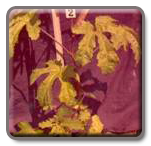 |
CO 1 (1976) |
|
It is a pureline selection from the 'Red Wonder' introduced from Hyderabad. The plants are medium tall and moderately vigorous and leaves are deeply lobed. The pods are slender, smooth, fleshy, linear and tender at edible stage. The flesh content is 72% with a mean seed content of 28%, crude fibre of 14.06%, starch and protein content of 14.80% and 18.08% respectively. The average yield per plant is 20 pods weighing 300 g. It yields 12 tonnes per hectare with a per day productivity of 150 kg/hectare. The crop duration is 90 days and 15-18 harvests can be done. The mean number of fruits per kg is 58. It is susceptible to yellow vein mosaic disease. |
MDU 1 (1978) |
It is an induced mutant from Pusa Sawani through gamma rays. The crop duration is 90 days. It can be cultivated throughout the year under irrigated conditions. The crop is adaptable to Southern districts of Tamil Nadu. The plants are dwarf with determinate plant growth having shorter internodes, each node bears fruits. The fruits are long, light green in color with less crude fibre content (12.3%). |
CO 2 (1987) |
It is a F1 hybrid between A.E. 180 and Pusa Sawani. The crop duration is only 90 days and yields 16.51 t/ha, with an increased yield of 26.30 to 64.05 per cent over other released cutlivars, viz., Co.1, MDU.1 and Pusa Sawani. Fruits are fairly long with a mean length of 20.60cm, girth of 6.8cm and each weighs 33g. The fruit contains 12.6% crude fibre, 15.2% starch, 19.2% protein, 2.84% fat and 50.5mg of ascorbic acid in 100 g of pulp. Fruit surface is less hairy with a better consumer's appeal and market preference equal to Pusa Sawani. It is suitable for both kitchen garden and commercial gardens besides as an intercrop. Not suitable for growing during summer season because of its susceptibility to yellow vein mosaic. |
 |
CO 3 (1991) |
|
It is high yielding F1 hybrid between Parbhani Kranti x MDU.1 (Hy.8). It exhibits moderate resistance to Yellow Vein Mosaic disease. This variety has an yield potential of 16-18 t/ha which is 56 per cent more than that of Parbhani Kranti. Suitable for growing during Kharif as well as summer. The fruits are dark green medium in size and suits to fresh market. |
 |
COBhH1 (2007) |
|
It is an VU Selection / PA 4 (T). Plants are 110-120 cm tall. Fruits are dark green, long and tender. About 21-29 fruits are borne per plant. It is a high yielding and resistant to yellow vein mosaic virus disease. it is suitable for cultivation without any pesticide spray. This can be cultivated during May – June, November – December and February – March. This is having a yield potential of 22.1 t/ha with an yiled increase of 47.30 % (Arka Anamika) and 16.30 % (M 10). This variety can be well adopted to Coimbatore, Dharmapuri, Erode, Kancheepuram, Madurai, Namakkal, Pudukkottai, Ramanathapuram, Salem, Sivagangai, Thanjavur, Trichy, Thiruvannamalai, Villupuram and Vellore districts under irrigated conditions. The total crop duration is 120 days. |
| Top |
| 6. Bitter gourd |
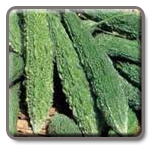 |
CO 1 (1978) |
|
It is a selection from a local type collected from Thudiyalur (Long Green). It yields 14.4 t/ha. The vines are moderate in growth with a length of 130 cm and 5 to 7 branches per vine. The fruit is dark green, medium long (25-30 cm) and thick (6-8 cm) with characteristic warts. Each vine produces 20-22 fruits each weighing 100120 g. Each fruit contains 24 to 30 seeds weighing 6 to 8 g. Vines flower in 45-50 days and first harvest can be had in 55-60 days after sowing. The total crop duration is 115 days with 6-8 harvests. |
MDU 1 (1984) |
It is an induced mutant developed by gamma irradiation to local cultivar (MC 103). It is early in flowering (60 days) with a sex ratio of 1:20 of female and male flowers. The fruits are long with a mean length of 40.34 cm and a girth of 17.54 cm and each fruit weighs 410 g on an average. It yields 32.19 t/ha. Fruits contain less seeds. Each vine yields on an average of 16.66 fruits. |
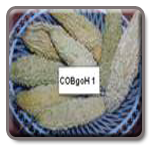 |
COBgoH1 (2001) |
|
It is a F1 hybrid developed by a crossing MC.84 x MDU.1 with a crop duration of 115120 days. It recorded an average yield of 44.4 tonnes/ ha. The average individual fruit weight is 300 g. The potential yield goes up to 51.29 tonnes/ha. June-Sept (Kharif) and Dec-March (Rabi) are ideal season for cultivation of this variety. Fruits at vegetable maturity are useful for making fried curies, porial and stuffed food. It is adaptable to Coimbatore, Pudukottai. Nagapattinam, Thanjavur, Tiruvarur, Vellore, Theni, Madurai and Virudhunagar. It has high momordicine content (2.99 mg/g). |
| Top |
| 7. Bottle gourd |
CO 1 (1981) |
It is a selection from a germplasm type. The stem is light yellowish green with light green leaves. The crop duration is 135 days with a yield of 36.0 t/ha. Fruits are round at the base with a prominent bottleneck at the top, medium sized, attractive light green in color with a mean weight of 2.03 kg. It is earlier by 15 days in crop duration as compared to local. |
Bottle gourd Hybrid CO1 |
- F1 hybrid developed by crossing NDBG 121 x Arka Bahar. Fruits are cylindrical, without crook neck, medium sized (0.95-1.00 kg) and suitable for nuclear family. Suitable for bower system of cultivation.
- Duration - 100 – 110
- Yield - 79.03 t/ha
|
| Top |
| 8. Brinjal |
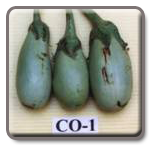 |
CO 1 (1978) |
|
It is a pureline selection with crop duration of 160 days. The plants are erect, compact and bushy with green stem and leaves and greenish purple petiole. The fruits are oblong and medium sized with pale green shade under white background. Each fruit on an average weighs 50 to 60 g with good keeping quality. The fruits are soft seeded even at full maturity. It is moderately resistant to root knot and reniform nematodes. It yields on an average of 24.0 t/ha. This variety is preferred in the markets of southern districts of Tamil Nadu (Tirunelveli, Ramanathapuram etc). |
 |
MDU 1(1979) |
|
It is a selection from Kallampati local type near Madurai. The crop yield per hectare is 34 tonnes with a duration of 135 -145 days. The variety is adaptable to tropical plains of Tamil Nadu. The plants are compact and medium spreading. The leaves are broad, green without pigments. Fruits are bright purple in color, round and each weighs 280 g with a pulp-seed ratio of 9:8, moisture content of 89%, protein content of 1.5%, acidity of 0.29%, ascorbic acid content of 14.0 mg per 100g, total carbohydrate content of 4.3% and TSS of 6.2%. As the fruit matures, the purple color fades to pale pink. This variety is preferred in Madurai and Trichy districts of Tamil Nadu. |
 |
PKM1(1984) |
|
It is an induced mutant of a local type called 'Puzhuthi kathiri'. It yields on an average of 34.75t/ha in a duration of 150155 days. The fruits-measure 6 to 8 cm and 10-14 cm in length and girth respectively with a mean weight of 55g. The fruits are small with green stripes. It is drought tolerant and can withstand long distance transport. It is adapted to rainfed cultivation in Madurai and Dindigul districts. The fruits store well under normal room temperature and contain 0.29% acidity and 14mg of ascorbic acid per 100g of pulp. |
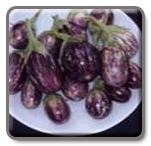 |
CO 2(1988) |
|
It is a pureline selection from the local variety 'Varikkathiri' of Negamum, Coimbatore district. The fruits are preferred in the districts of Coimbatore and Erode. The plants are compact and erect. The fruits have dark purple stripes intermingled with light green color. They are oblong in shape with smooth calyx. The crop yield is around 35 t/ha in a duration of 150 days. |
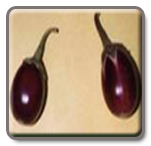 |
PLR 1(1990) |
|
It is a reselection from a Nagpur ecotype. It yields on an average of 25.1 t/ha and fetches premium price (20 per cent more) over Annamalai variety in the markets of South Arcot, Chengelpet and Chennai. lt possesses extended shelflife (upto 10 days) and is suitable for growing in all the seasons. It is cluster bearing in nature and the fruits are medium sized, egg shaped, dark purple and glossy in appearance, which are preferred by the consumers. It has a higher ascorbic acid content of 12 mg/100 g. |
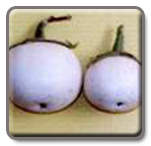 |
KKM 1(1995) |
|
It is a pure line selection from Kulathur local near Tirunelveli. It is suitable for cultivation in both irrigated and rainfed conditions. Fruits are borne in clusters with 2-4, egg shaped with milky white color. The crop duration is 130-135 days, and yields 37 t/ha. This variety is preferred in the markets of Southern districts. |
 |
PPI(B) 1 |
|
This is a single line selection (PPI (B) 1) from Karungal local type Vazhuthunangai and yields 50 t/ha in a duration of 185 days and recorded 23 per cent higher yield over Arka Shrish. It is medium spreading with 30-35 lengthy pale green fruits, less seeded and bitter less. It is medium tolerant to brinjal fruit and shoot borers and wilt disease. It is suitable for cultivation during April-May, Oct-Nov (as rainfed and irrigated crop) in Kanyakumari district. |
 |
COBH 1 (2001) |
|
It is a F1 hybrid between EP 45 x CO.2 released from HCRI, Coimbatore. High yielder recording an average yield of 56.40 tonnes /ha in about 120 to 130 days after transplanting. April – December is ideal season for cultivation of this variety. The fruits are medium sized, oblong in shape and dark violet in color. The average single fruit weight is 60-65 g. It possesses higher ascorbic acid content (16.65 mg/100 g). It is adaptable to Coimbatore, Erode, Salem, Namakkal, Trichy, Karur, Dharmapuri and Tiruvannamalai districts as irrigated crop. |
PLR(B) 2 (2008) |
It is developed by single plant selection from Sevanthampatti village of Trichy District. The fruits are oval in shape, dark purple with pink tinge and glossy. The fruit has excellent cooking quality and suitable for all types of culinary preparations. It has the consumer preference for its better taste, flavour, texture & colour. It is moderately resistant to brinjal shoot and fruit borer and suitable for cultivation for all seasons. The crop duration is 145 days and yields about 38 t/ha which is 15.4% increase over PLR 1. A highest yield of 42t/ha was obtained from this variety. This variety is suitable for Cudalore, Villupuram, Tiruvannamalai, Vellore, Kancheepuram and Perambalur districts. |
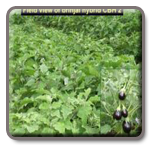 |
COBH 2 (2009) |
|
- F1 hybrid developed by crossing EP65xPusa Uttam. Medium sized, slightly oblong and glossy violet colour fruits
- High ascorbic acid (16.5 mg/100g) Moderately tolerant to shoot and fruit borers
- Duration - 120-130 days
- Yield - 58-60
|
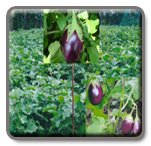 |
VRM1 (2010) |
|
- Pureline selection
- High yielding
- Spines on leaf, stem and calyx
- Cluster bearing
- Fruits oval in shape, glossy pink in colour with green tinge in the distal end
- Resistant to leaf spot, veriticilium wilt and epilachna beetle
- Duration - 140-150 days
- Yield - 40-45 t/ha
|
| Top |
| 9. Butter beans |
KKL 1(1991) |
KKL 1 Butter beans is a selection from a type collected from Vilpatti. It is a pole type growing up to 2.42m and bears pods in clusters. The pods are 11.6 cm long, beans are 5 to 6 in number per pod. The pods are green when immature, turning creamy yellow with brownish purple streaks on the surface at maturity. The seeds are bold, globular, snow white in colour and with excellent cooking quality. The variety is suited for hilly regions of Tamil Nadu from an altitude of 1200m to 2200m above MSL. The crop will be ready for first harvest from 100 days after sowing. The harvest will continue upto 140 days. It yields 3.47 tonnes of ripe pods per hectare in three to four pickings. |
| Top |
| 10. Carrot |
 |
Ooty 1 (1997) |
|
This is a selection from half-sib progeny of a local type (D.C.3). The roots are long and slightly tapering with attractive deep orange color. Suitable for growing in hilly areas at altitude above 1800m. The crop is medium in duration (100-110 days) and suitable for growing in all the three seasons throughout the year. The central core is thin, fleshy and palatable. The crop is free from premature bolting and resistant to powdery mildew, leaf spot and drought. The roots are rich in Beta-carotene. It yields 49.1 t/ha with a seed yield of 700-1000 kg/ha. |
| Top |
| 11. Cauliflower |
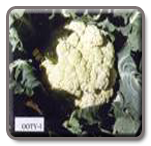 |
Ooty 1 (1998) |
|
It is a selection from OP progenies of local types and released from Horticultural Research Station, Ooty. The crop can be raised throughout the year. The curds are attractive creamy white in color, uniform and big sized. Each curd weighs 2.6 kg and is free from riceyness. This variety yields 46.4 t/ha in 120 days, which is 52% more over local variety. The curds have good keeping quality of 7 days in hills and 5 days in plains. It is suitable for growing in hilly areas at 1800 above MSL. Commercial seed production is also possible in the Nilgiri hills. |
| Top |
| 12. Cerely |
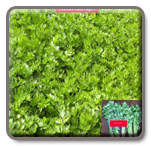 |
Ooty 1 |
|
- Selection from the six germplasm types
- Grows 900m above MSL
- The seed oil content is 1.71 %
- Resistant to white flies, aphids and root knot nematode (Meloidogyne incognita) and leaf blight
- Duration - 115 days
- Yield - Greens - 30.5 t/ha
- Seed - 1.40 t leaves /ha
|
| Top |
| 13. Chakravarthikkeerai |
 |
Ooty 1(2001) |
|
It is a pureline selection made from CA-3-1, released from Horticultural Research Station, Ooty. Plants can grow upto a height of 38.2 cm with green yield of 28.9 tonnes/ha (59 per cent higher than local). It can be grown throughout the year. If it is grown in plains, it yields 17.0 tonnes/hectare. It is ready for harvest within 55 days in hills and 50 days in plains after sowing. Leaves are attractive green with pink tinge with good cooking qualities (rich in proteins and minerals). It is also suitable for grain with yield of 1.2 tonnes/ha in a crop duration of 145 days. It can tolerate drought and severe winter. It is resistant to Cercospora leaf spot, Colletotrichum leaf spot and Macrophomina root rot. Good keeping quality 5 days in hills and 2 days in plains. Seed production is possible in all three seasons in the Nilgris. It is adoptable under higher, middle and lower elevations on the hills (500 to 1500 m above MSL). |
| Top |
| 14. Chilli |
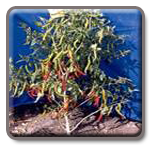 |
K 1 (1964) |
|
It is a pure line selection from local Sattur Samba developed at Agricultural Research Station, Kovilpatti. The plants are tall and spreading. The crop duration is 210 days, yields 1.8 tonnes of dry pods/ha and suitable for rainfed cultivation in Southern Districts of Tamil Nadu. The ripe fruits are red, long and contain high capsaicin. |
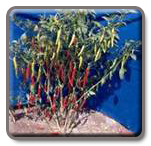 |
K 2 (1975) |
|
It is a hybrid derivative of the cross between B.70 A (Assam type) x Sattur Samba. The plants are erect with a height of 90.2 cm. The stem color is green when young and grey on maturity with green leaves. The pods are green when unripe and turns to red at ripening with firmly attached calyx, compressed base and pointed beak. It yields 1.9 tonnes of dry pods in a crop duration of 210 days. The length and girth of pod is 7.0 and 4.0 cm respectively. This variety has recorded an increased yield of 29% over K.1 chilli. |
MDU 1 (1978) |
It is an induced mutant from K.1 chillies by using 30 KR of gamma rays. It is, compact plant type with broad and dark green leaves and determinate growth habit with less number of secondary branches. The fruits are borne in clusters of 4 to 9 at nodes as against single fruit borne at nodes in K.1 or K.2 varieties. The fruits are long with dark shiny red color. It has total duration of 205 to 215 days and gives a dry pod yield of 1809 kg/ha under irrigated conditions representing an increase of 15.1 per cent over K.2 chilli. |
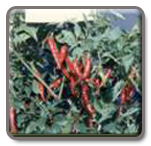 |
CO 1 (1979) |
|
It is a reselection from Sattur Samba [CA (p) 247]. The crop duration is 210 days and yields 2110 kg of dry pods per hectare. The plants are erect, medium tall and compact with medium branching. The fruits are green when unripe and bright shiny red on ripening. The fruits are 6.0 to 6.5 cm long with sharp tip and bulged shoulder. The seed content is 55 per cent. The variety has high capsaicin content (0.72 mg/g). |
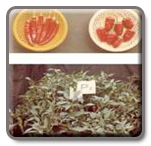 |
CO 2 (1982) |
|
It is a selection from Nambiyur local 'Gundu' type of Erode district of Tamil Nadu [CA (p) 63]. The crop duration is 210 days and yields 2200 kg of dry pods per hectare. The stem is angular, semidwarf and less spreading. The fruits are oblong, thick and bright red in color. Seed content is high (60%). The capsaicin content of dry pod is 0.56 per cent. It is suitable for harvest both as green pods and red ripe pods. The green pod yield is about 11 t/ha. |
 |
PKM 1 (1990) |
|
This is a hybrid derivative of the cross between AC. No. 1797 x CO.1 selected in F4 generation and fixed by selfing and released from the Horticultural College and Research Institute, Periyakulam. Plants are dwarf (70 cm). The crop duration is 180 days. It is suitable for cultivation under irrigated conditions. It yields on an average of 3.08 t/ha with 39.83% increase over CO.1. It has very bold pods, which are dark red in color. The number of pods per plant is 204 with 85 seeds per fruit. Fruits contain 0.36% capsaicin with a high ascorbic acid content of 306.0, 269.8 and 67.0 mg/100 g of green, ripe and dry pod respectively. |
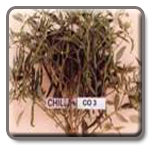 |
CO 3 (1991) |
|
It is a selection from an open pollinated type introduced from Sri Lanka (CA, 856). The fruits are long, slender with attractive dark green color before ripening and turns to deep red color after ripening. They are borne underneath the canopy and less affected by heavy wind, dwarf and amenable for close planting of 30 cm x 15 cm. The potential yield at this spacing is 3000-3500 kg of dry chilli and 15-18 tonnes of green chilli per hectare. It is also suitable to be used us green chilli. It has a very low stalk/pod ratio (6.6), high oleoresin (13%) and capsaicin (0.402 mg/g) and hence suitable for export purpose. It is suitable for use as both green and dried chilli. The crop duration is 165 days. |
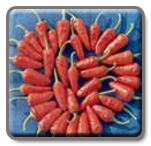 |
PMK 1(1993) |
|
It is a hybrid derivative of a cross Co.2 x Ramanathapuram gundu (Local) and released from the Agricultural Research Station, Paramakudi. It is suitable for semi-dry cultivation during Rabi season (North East Monsoon) in Ramanathapuram district. It can also be recommended for other dry areas where similar conditions exist. The variety yields on an average of 2.36 tonnes of dry pods per hectare, accounting for yield increase of 29.43 per cent over Co.2 and 53.24 per cent over local. The crop duration is 200 days. The plants are medium tall with spreading branches. The fruits are conical in shape with attractive red color with 0.36 per cent capsaicin content. |
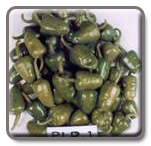 |
PLR 1 (1994) |
|
It is a pureline selection [CA (Q) 8] from Kanchengadu local type suitable for cultivation as green chillies. It yields 18.41 tonnes of green chillies/ha, which is 13.3% increase over CO.2, and 23.5% over local type in a crop duration of 210 days. It is adaptable to North Eastern Zone of Tamil Nadu and cultivated during December-January season. The plants are dwarf statured and produces bigger sized fruits (190/plant). The harvest can be prolonged by increasing the number of pickings. The fruits are also used for pickling. It tolerates salinity in the soil. The fruits are pendulous, medium in size (8.66 cm length and 8.54 cm girth) with bulging base and blunt tip, glossy green appearance. The first picking starts 60 days after transplanting and completes in 180 days. |
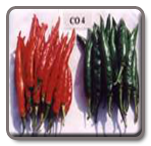 |
CO 4 (2000) |
|
It is a pureline selection made from an open pollinated type introduced from Sri Lanka released from the Horticultural College and Research Institute, Coimbatore. The plants are dwarf, closely branched, suitable for close planting. The fruits are dark green and stout (6.5 g) with low pungency (0.29% Capsaicin). It yields 23 t/ha of green fruits as against 11.73 t/ha in PKM.1 with a crop duration of 165 days. Suitable for making chutney, curry and pickles. Adapted to fertile loamy soils of Coimbatore, Erode, Dindigul, Karur, Thanjavur, Nagai, Tirunelveli, Tuticorin and Kanyakumari districts. |
 |
KKM(Ch) 1 (2006) |
|
This is a hybrid derivative of Acc. 240 / CO-3 and suitable for cultivation during September – October. It is a high yielder with duration of 200 days. The plants are dwarf, compact and spreading. Fruits are attractive red in colour and do not shrink much after drying and hence could fetch better price in market. Relatively, it has high capsaicin content (0.54%), oleoresin content (14.3%) and seed content (49.79 Nos. / pod). It has moderate resistance to fruit rot (Percent Disease Index value 1.10) and field tolerance to mosaic disease (Percent Disease Incidence value 3.02). It yields about 3.03 tonnes of dry pod / hectare which is 35.61% increase over PKM 1 and 38.41% increase over K 1. a highest yield of 3.762 t/ha was obtained from this variety. It is suitable for cultivation in Tirunelveli, Thoothukudi, Virudhunagar and Ramanathapuram regions under garden land condition.
|
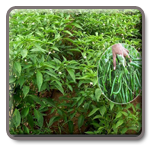 |
CO CH 1(2010) |
|
- Plants semi tall, spreading and highly branched
- Unripe fruits light green in colour, elongated, tapering towards the tip and 10.5 – 12.0 cm long
- Capsaicin and oleoresin contents of 0.58 % and 14.0 % respectively
- Ascorbic acid 120 mg/100 g fruit
- Moderately resistant to fruit rot disease
- Duration - 195-205 days
- Yield - Green fruit yield: 28.10 t/ha
- Dry fruit yield : 6.74 t/ha
|
| Top |
| 15. Coccinia |
CO 1 |
- Clonal selection from Anaikatti type. Fruits are long, green with white stripes, less seeded and sweet (4.5o Brix). Suitable for culinary purpose.
- Duration - Perennial
- Yield - 83.09 (t/year)
|
| Top |
| 16. Coleus |
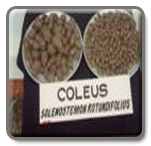 |
CO 1 (1991) |
|
It is a clonal selection from local type introduced from Tenkasi. It yields 31.93t/ga in crop duration of 180-190 days. The tubers have 21.5 per cent starch. The cooked tubers are tasty and have lesser soil odor. |
| Top |
| 17. Colocasia |
 |
CO 1 (1991) |
|
It is an introduction selected from the germplasm maintained at Horticultural College and Research Institute, Coimbatore. It yields 24.3t/ha. Tubers have high starch content of 22.5% and higher protein content of 2.4%. Tubers have less acidity and good cooking quality. Top |
| 18.Cowpea |
 |
PKM -1 (2011) |
|
- High green pod yield
- Very long pods 40 - 45 cm with cluster bearing (3 – 4 / cluster)
- Semi trailing and highly branched
- Seeds mottled with brown and grey colour
- First harvest at 45-50 days
- Fibre content- 0.89 g and crude protein content – 21.88 (mg /100 g)
- Duration - 90 – 100 days
- Yield - Green pod yield - 25 t/ha
|
| Top |
| 19. Cucumber |
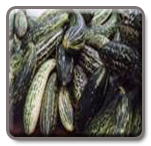 |
CO 1 (1989) |
|
It is a selection from a local type of Kanyakumari District. It yields (25-28 t/ha) of ripe fruits with a good, attractive color. The fruits are long (60-65 cm), slightly curved, apering towards stalk end, fairly big and each weighs 2.0 to 3.0 kg at ripe stage. It has got a good consumer appeal and market preference. The fruits can be picked at early stages (7-8 days after flowering) for use as tender fruits for salad, at well matured stage (16 days after flowering) for vegetable and at ripe stage (bright yellow with greenish yellow intermittent stripes) for dessert purposes along with sugar or jaggery. As a tender vegetable for salad it yields 15 t/ha in a crop duration of 100 days. |
| Top |
| 20. Dolichos bean |
 |
CO 1 (1993) |
|
It is a pureline selection (Dolichos lablab var.typicus) from a type collected under All India Co-ordianted Vegetable Improvement Project. It is earlier than other pandal varieties. The pods are ready for harvest in 80-85 days after sowing. The total crop duration is less (165 days) as compared to 210 days in CO.5 lab lab. It yields 18 tonnes of green pods per hectare. The pods are dark green, flat and slightly curved, tender and fleshy with better consumer's preference and market appeal. The matured seed is black with white hylem. The 100 seeds weight is 60 g. 100g of edible pods contain 4.69% protein, 0.12% vitamin C, 0.2% Fe, 0.14% phosphorous, 0.39% calcium and 1.33% crude fibre. |
|
Top |
| 21. French beans |
TKD 1 (1988) |
It is a pole type selected from germplasm population at Horticultural Research Station, Thadiyankudisai. Pods are less fibrous. The crop duration is 90 days. It yields 5.6 tonnes of green pods/ha. Dry seed yield is 2.78 t/ha. Seeds turn white in maturity used for cooking. Suitable for growing in the hill ranges of Tamil Nadu, viz., Shevroys, Palani hills and Nilgiris. |
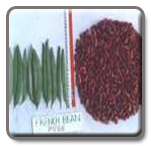 |
YCD 1 (1994) |
|
It is a pure line selection from a local indigenous type collected from Shevroy hill ranges of Tamil Nadu. The variety is a dual purpose one, useful as green pod and grain. It is adaptable to the rainfed situations of Shevroys. It is suitable for cultivation in Kharif (June-July) season and possesses a higher yield potential of 9.75 tonnes of green pods per hectare and grain yield of 6.3 t/ha. The yield increase is 29.1% (green pod) and 18.9% (grain) respectively over the variety Premier. The plants are semidwarf and bushy and grow to a height of 35.5 cm. It flowers in 35-50 days after sowing. The total crop duration is 105 days. The pods are slightly flat, long (15.1 cm), broad (1.13 cm) and robust (7.76g). Seeds are bold, attractive, dark purple in color and each weighing 0.76 g. It is field tolerant to root rot, rust, yellow mosaic and anthracnose. |
Ooty 1 (1999) |
It is a pure line selection from accession PV-26 maintained at Horticultural Research Station, Ooty with a crop duration of 80 days. Season includes February –March, April-May and July-August. It is a pole type adapted to temperate zone from 1800 to 2500 m above MSL. It yields 33.68 t/ha, which was superior over local by 52.7% and over KKL.1 by 40.5%. The pods are moderately resistant to leaf spot, anthracnose and pod borer. The pods are fleshy, stringless, with less fibre and high protein content (17.15%) |
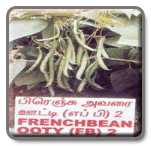 |
Ooty 2 |
|
Ooty (FB) 2 is a single line selection from PV 15-1. It is dwarf and dense plant, bears round, fleshy fiberless, pale green pods. It contains high protein (22.38 per cent), calcium (1.22 per cent) and magnesium (0.34 per cent) and highly suitable for cooking. It is medium tolerant to pest and diseases. It has recorded a yield of 14.30 t/ha of green fruits in 90 days crop duration. It is 34.2 and 49.95 per cent higher yield than Arka Komal and Local type respectively. It is suitable for cultivation during Feb-Mar, April-May and July-Aug. It is suitable for districts like Nilgris and places of more than 1000 m MSL. |
| Top |
| 22. Garlic |
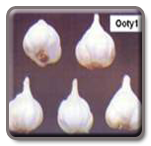 |
Ooty 1(1991) |
|
It is a clonal selection from the germplasm assembled at Horticultural Research Station, Ooty. It has a potential yield of 17.1 t/ha under Ooty conditions. The crop duration is 120-130 days. The bulb is big and dull white in color and weighs 30 to 40 gm each. Each bulb contains 20 to 25 cloves. The cloves have a flattening surface inside. It is moderately resistant to blast and resistant to thrips and tip drying caused by foliage nematode. |
| Top |
| 23. Greater yam |
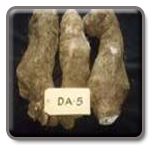 |
CO 1 (1991) |
|
It is a clonal selection from the germplasm introduction maintained at the Department of Olericulture, Horticultural College and Research Institute, Coimbatore. It yields 44.8 tonnes of tubers/ha in a crop a duration of 8 to 8.5 months. The tubers are big with white flesh. Tubers are rich in carbohydrate (28%) and protein (2.5%). |
| Top |
| 24. Moringa beans |
KKL 1 (1996) |
It is a pureline selection from local type collected from Pallangi village of Kodaikanal taluk. The crop duration is 140-160 days. It yields 7t/ha of green pods, and is 30.9% higher than the local type. It is suitable for South Indian hills from an altitude of 1200m above MSL. The green pods are fleshy and thick skinned. Seeds are also used for cooking which are rich in protein, minerals and vitamins. They are white in color. |
| Top |
| 25. Onion |
CO 1 (1965) |
It is a clonal selection from a germplasm type CS 450 introduced from Manachanallur. The crop duration is 90 days and yields 10t/ha. Bulbs are medium in size, red in color. The bulb weight per plant is 55 to 60 g with an average of 8 bulbs per plant. The plant is medium in height (30cm) with green leaves. It is fairly pungent with a medium TSS content (8-9° brix). |
CO 2 (1975) |
It is a selection from a germplasm type C.S. 911. The crop yields 12t/ha in 65 days. The bulbs are crimson in color and moderately bigger in size. The bulb weight per plant ranges from 60 to 65 gm, with an average of 9 bulbs per plant. The leaves are green with cylindrical shape. The plant height is 30 cm. The number of shoots per plant ranges from 7 to 9. The weight loss during storage is lesser than CO.1. This variety is pungent with high TSS content (12° brix). |
CO 3 (1979) |
It is a clonal selection from open pollinated progenies of C.S. 450. The crop duration is 65 days and yields 15.8t/ha. The bulbs are pink in color and bolder in size. The bulb length and girth are 3.5cm and 8.3cm respectively. The mean bulb weight per plant is 75g. The number of bulbs per plant ranged from 8 to 10. The plant has light green erect cylindrical leaves. The plant height is 40cm. The number of shoots ranges from 6 to 8. The bulbs are bigger than CO.2 with good consumer’s appeal. The plants are moderately resistant to thrips. The bulbs store well for 120 days devoid of sprouting in well ventilated store rooms. The variety contains 17.5% dry matter with 0.53 per cent sulphur and 13.0 per cent TSS. |
MDU 1 (1979) |
It is a selection from the Sempatti local. This variety has uniform big sized bulbs with bright red colur and better keeping quality with our any weight loss. It’s yield potential was 13,000 kg /ha. |
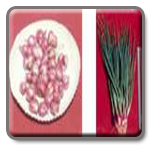 |
CO 4 (1982) |
|
It is a hybrid derivative of the cross AC863 x CO.3. The crop duration is 65 days and yields 19.0t/ha. The leaves are light green, erect and cylindrical. The number of bulbs per plant varies from 8 to 13 with an average weight of 90g per clump. Bulbs are attractive light pink, bold in size with good consumer appeal. The bulbs store well over 150 days. |
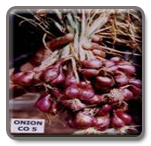 |
COOn 5 (2001) |
|
It is a high yielding variety developed by mass pedigree method of selection. This variety has the ability of free flowering and seed set throughout Tamil Nadu. It possess high bulb yield 18.9 t/ha (18.8 per cent higher than CO.4) in a crop duration of 90 days. It is free flowering type with seed setting ability of 250-300 kg/ha and so it is propagated through seeds. March–July for bulb production and November– January for seed production. It possesses attractive pink coloured bold size bulbs. The total soluble solids content is 13 per cent. The pungency principal measured as pyruvic acid is 2.37 µm/g of fresh weight. It is adaptable to Coimbatore, Trichy, Pudukottai, Nagapattinam, Thanjavur, Tiruvarur, Theni, Madurai, Namakkal, Cuddalore, Tiruvannamalai, Thoothukudi, Erode and Dharmapuri districts. |
| Top |
| 26. Palak |
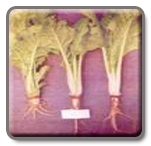 |
Ooty 1 (1995) |
|
Ooty 1 palak is a tasty green leafy vegetable released during 1995. It can be grown throughout the year and can withstand frost. Leaves are green and rich in Vitamin A. It is a selection from local type in which first picking can be obtained in 45 days after sowing and continued at 15 days intervals for a period of 2 years. It yields 15t/ha of leaves. The carotene content is high. |
| Top |
| 27. Peas |
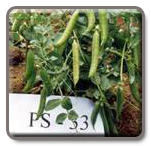 |
Ooty 1 (2000) |
|
It is a pureline selection (PS-33-1) among 40 germplasm types maintained at Horticultural Research Station, Ooty. The crop duration is 90 days and is suitable for all the three seasons in the Nilgiris district. The plants are dwarf with dark green, long and smooth pods with 9 seeds. The pods have good cooking quality. The crop yields 11.1 t/ha under rainfed conditions and 12.9 t/ha under irrigation. The seeds contain high protein (19.94%), ascorbic acid (18.2 mg/100 g) and total sugars (2.8 mg/g). The variety is resistant to white fly and suitable for growing in temperate zones of Nilgiris from 1600 to 2500 m above MSL and other similar areas. Also suitable for well drained loamy soils. |
| Pole type Ooty 1 |
- Pure line selection. Plants grow to 2m tall. Pods are fleshy and stringless.
- Duration - 80 days
- Yield - 33.7 t/ha
|
| Top |
| 28. Potato |
CO Simla potato
(1970) |
It is a selection from the hybrids obtained from CPRI, Simla. It is suitable for cultivation in the plains during monsoon seasons. The yield is 12t/ha in a crop duration of 110 days. The tubers are medium in size. |
| Top |
| 29. Pumpkin |
CO 1 (1971) |
It is a selection from local type. The crop duration is 180 days and yields 25-30 t/ha, with good cooking quality. The crop duration is 150-160 days. The vine is vigorous and spreads upto1.2m. The stem often roots at the nodes and has 8 to 10 branches. The peduncle is angled with late maturing globular fruits. The fruits are flattened at the base measuring 34 cm length and 26.0 cm girth. The flesh thickness is 4 to 5 cm. The seed content is less (1.2%) and each plant bears 6 to 7 fruits/plant. Each fruit weighs about 7.0 kg. The first harvest can be done in 115 days. It is moderately resistant to pests and diseases. |
CO 2 (1974) |
It is another selection from a local type. The vines are moderately vigorous, less spreading than Co.1 and adopts well for high density planting at 2.2 x 1.9 m spacing. Vines flower in 55 days after sowing and first harvest can be had in 95-100 days. The crop duration is 135 days with a mean yield of 22.65 t/ha. Fruits are small sized, slightly ridged with bright orange colored flesh. Each fruits weigh on an average of 1.5 to 1.8 kg. The fruits contain 10.8% TSS, 3.4% total sugars, 1.9% reducing sugars, 9.2% starch, 10.0 mg/ of ascorbic acid in 100 g of pulp, 0.14% acidity with an organoleptic scoring of 75%. The seed yield is 450 kg/ha with a flesh to seed ratio of 50:1. |
| Top |
| 30. Radish |
CO 1 (1981) |
It is a selection from germplasm type (RS 44). The crop duration ranges from 40 to 45 days and hence suitable for cropping systems. It yields 20-25 t/ha. The roots are milky white, long (22 cm) thick 12.5 cm girth) and each weighs 220 g. The roots contain 10.9 mg of vitamin C per 100g and 1.20% crude fibre. This variety is suitable for growing all the year round under different cropping systems. It bolts and sets seeds in the plain and hence very easy for the farmers to produce seeds themselves. Roots have better consumers' preference. Top to ratio is 0.99. |
| Top |
| 31. Ribbed gourd |
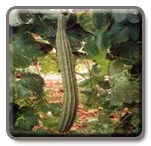 |
CO 1 (1976) |
|
It is a selection from the type collected from Aduthurai. The vines are medium spreading (5.0sq.m). Fruits are big sized (60-75cm long), thick (30cm), prominently ribbed, attractive green color, each weighing 425g on an average with yellowish green colored thick crisp flesh. The seed content is medium (200-300 seeds weighing 20-30g) with a seed yield of 420kg/hectare. It yields 14t/ha. It is free from the attack of fruit fly. A quantity of 100 g edible fruit contains 3.5g carbohydrates, 0.9g proteins, 0.2g fat, 0.4 g fibre, 42.0mg calcium, 37.0 mg phosphorous, 37.0 mg potassium, 1.7 mg iron, 4.2 mg sodium, 12.0 mg sulphur, 5.0 mg ascorbic acid with an organoleptic scoring of 75 per cent. |
PKM 1 (1980) |
It is an induced mutant from the type H.160. It yields 25-28 t/ha in a duration of 160 days. The fruits are dark-green 60-70 cm long with shallow grooves. They are characterized by very broad terminal end than the basal end. The plants are tolerant to pumpkin beetle, fruit fly and leaf spot. |
CO 2 (1984) |
It is a selection from a germplasm type. Each vine produces 8 to 10 fruits weighing 9 to 10 kg. The fruits are green, very long (1m) and fleshy. The crop duration is 120 days with a yield of 25 t/ha. |
| Top |
| 32. Snake gourd |
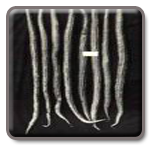 |
CO 1 (1976) |
|
It is a pureline selection from one of the types collected from Alangulam, Tirunelveli district. Vines are moderately vigorous and medium spreading, (5.0 square meters). Fruits are dark green with white stripes, long (160-180 cm), each weighing 500 to 750g on an average. The crop duration is 135 days and yields 18.28 t/ha with an increase of 10 per cent over the local. The flesh is smooth, light green and with good cooking quality. |
PKM 1 (1979) |
It is an induced mutant from H.375 and yields on an average of 25.5 t/ha in crop duration of 145 days. The vines are vigorous growing. Fruit color is dark green with white stripes on outer side and light green inside, with a mean fruit weight of 700 g. The fruits are extra long (180-200 cm) and suitable for growing all through the year. |
MDU1 (1981) |
It is a F1 hybrid between Panripudal and Selection-1 from Thaniyamangalam. It is an easily flowering type (84 days) with a sex ratio of 1:38. It produces 13 fruits per vine weighing 7.15 kg with an average yield of 31.75 t/ha in a crop duration of 145 days. The fruits are medium long (66.94 cm) with white stripes under green background. Each fruit on an average weighs 55g. The fruits are fairly rich in vitamin-A (44.4 mg/100g) and very low in fibre content (0.6%). |
 |
CO 2 (1986) |
|
It is a pureline selection from a local type of Coimbatore district. The fruits are short and stout. It yields on an average of 36 t/ha. The fruit is light greenish white and each weighs 400-600g. The crop duration is 105 days. The variety does not require pandal. The vines are less spreading and hence seeds can be sown at close spacing of 1.5 x 1.5 m. |
 |
PLR(SG) 1 (2007) |
|
It is a pure line selection from white long type. This variety is suitable for cultivation under irrigated conditions only. Excellent cooking quality due to less fibre and high flesh content and does not twist due to maturity. This is having a yield potential of 35 – 40 t/ha with 30.50 % increase over CO 1. This variety can be cultivated during June – September, November – March and April – May. It is highly adoptable to Cuddalore, Villupuram, Vellore, Tiruvannamalai, Kancheepuram, Tiruvallur and Perambalur districts of Tamil Nadu. It thrives best in well drained, organic matter rich, sandy loam soil. |
 |
PLR (SG) 2 |
|
- Fruits are plumpy, fleshy with attractive white colour
- Less fibre content Excellent cooking quality
- Average single fruit weighs 600 gm
- Preferred in the local and super markets
- Short fruit enables easy handling and long distance transport
|
| Top |
| 33. Newzealand spinach |
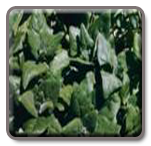 |
OOTY (Sp) 1 (2005) |
|
It is a pure line selection from germplasm types. This is having high yield potential, the leaves are attractive green in colour with excellent cooking quality. Leaves contain high Protein (28.79 %), Fat (4%) Calcium (0.34%) and Magnesium (0.084%) and highly resistant to drought and frost, can be grown as a cover crop. It is resistant to Cercospora leaf spot, root knot nematode, whiteflies and aphids. Good keeping quality upto 6 days in hills and 3 days in plains after harvest, which facilitates to market to the distant places. This can be cultivated during April-June (main), Aug.–Oct. (autumn) and February - April (irrigated). This is having a yield potential of 33.80 t/ha of greens which is 38.50 % increase over local cultivar. This can be cultivated in Nilgiris of 900 to 2500 m above MSL and similar areas. Suitable for well drained loamy soil with a pH of 3.5-6.0. The crop duration is 135 days. |
| Top |
| 34.Sweet potato |
CO 1 (1976) |
It is a clonal selection (IB 3) from a type collected from Tiruchirapalli district. The clone yields on an average 28.33t/ha of tubers with a range of 22.13 to 38.54 tonnes. The plants are moderate and less spreading with medium lobbed dark green leaves. The mean increase in yield over local is 17.6 per cent. The clone is tolerant to root weevil infestation registering only 11 to 15 per cent. The crop duration is 135 days. Each vine produces 3.2 tubers per vine weighing 1.12 kg. The tubers have pink skin and white flesh with a starch content of 24.2 per cent. Raw tuber tastes saltish sweet while it is sweet on cooking with firm consistency. Tubers contain 10.6% TSS, 1.2% acidity. 1.6% reducing sugars, 9.7% total sugars and 20 mg per 100g of ascorbic acid. |
CO 2 (1980) |
It is a clonal selection (IB 81) of seedling progeny obtained from open pollinated seeds of a type (IB 37) in germplasm bank. It yields on an average of 32t/ha. The crop duration is only 110 to 115 days when compared to 135 days in CO.1 and 140 to 150 days in other types. Vines are dwarf and erect. The tubers are medium sized with light pink skin and white flesh containing a high starch content of 29.5 per cent and carotenoids of 3.2mg per 100g. The root weevil incidence is only 10 to 15 per cent. The variety has better consumers' appeal and growers' preference. |
 |
CO 3 (1982) |
|
It is a seedling clone (IB 2837) obtained from the seeds of random mating population of IB 758. The crop duration is 105 to 110 days, which is less by 5 to 10 days with CO.2. The mean yield of marketable tubers is 43.68t/ha compared to 32.00t/ha in CO.2. Tubers are markedly rich in carotenoids (13.28 mg/100g) and starch (30.72 per cent). The tubers are medium sized with red skin and deep orange flesh. The root weevil (Cylas formicarius) incidence ranges from zero to 3 per cent. The per day production is 397 kg/ha. The tubers have rich ascorbic acid (21.1 mg/100g) and amylopectin (81.31 per cent) contents. The clone has better consumers' preference than the other clones. |
 |
COCIP 1 (1999) |
|
It is a clonal progeny of IB 90-10-20 developed through half sib evaluation of open pollinated seedlings released from the Horticultural College and Research Institute, Coimbatore. Suited to September –October (Main), February – March and June-July planting with the short crop duration of 95-100days. It yields 31.76 t/ha (tubers), which is 25.7 per cent higher yield over CO.3. It is adapted to entire Tamil Nadu. The tubers are tolerant to weevil incidence with better market appeal. The tubers have attractive pink skin with yellow flesh. Suitable for making cutlet, chips RTS beverage and mash. |
| Top |
| 35. Tapioca |
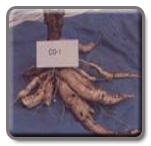 |
CO 1 (1977) |
|
It is a clonal selection from a local type (ME 7) collected from Triuchirapalli district. The plants are with dark green foliage with grayish stem, petiole is pink or pinkish green. The crop duration is 8.5 to 9 months, which is less when compared to 10 to 11 months in other clones under cultivation.The tubers have whitish brown skin with cream rind and white flesh. Starch content is 35 per cent with a total outturn of 10.33 tonnes of starch per hectare. The plant produces 8 to 10 tubers weighing 2.5 to 4.0 kg with a length and girth of 28.5 and 5.8 cm respectively. The clone yields on an average of 29.97 tonnes of tubers per hectare with a range of 22.90 to 36.50 tonnes. The clone records very low incidence of mosaic virus ranging from 0 to 8 per cent. The HCN content of tubers is very low i.e. 10µg/g in the flesh and 185µg/g in the rind. |
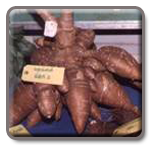 |
CO 2 (1984) |
|
It is a clonal selection (ME 167) from an open pollinated seedling progenies raised from the seeds collected from Thiruvarur District. It exhibits
field tolerance to cassava mosaic virus disease. It is a branching type with compactly arranged tubers having brown skin, creamy white rind and creamy white flesh. It flowers profusely. It is suitable for consumption as well as starch industry. It yields 35-37 t/ha in crop duration of 8 to 8.5 months. The starch content in the tuber is 34.50% with an outturn of 10.25t/ha. Tubers have low HCN content of 10µg/g. |
MVD 1 (1983) |
It was released by the State Department of Horticulture from Tapioca Experiment Station, Mulluvadi of Salem District, Tamil Nadu. It yields 34.5t/ha in a crop duration of 9 months. The tubers contain 35% starch. It is a non-branching type and exhibits field tolerance to mosaic virus disease. It is suitable for staple food and industrial uses. |
 |
CO 3 (1993) |
|
It is a clonal selection (ME 120-1) from seedling progenies of open pollinated seeds obtained from IITA, Ibadan, Nigeria. The plants exhibit branching habit. Since the plants are heavily branching, periodical removal of sprouts is necessary. It yields on an average of 42.58 t/ha of tubers under irrigated and 27.31 t/ha of tubers under rainfed conditions respectively. It is suitable for cultivation both under irrigated and rainfed conditions. It produces 8-10 tubers per plant. The tubers have dark brown skin with yellowish white rind and white flesh and contain a high starch of 35.6 per cent. The tubers taste sweet with a low HCN content of 77.89µg/g. The plants exhibit field tolerance to cassava mosaic virus. The crop duration is 8 months. |
 |
CO 4(2002) |
|
CO (TP) 4 is a clonal selection from one of the seedling progenies of the hybrid SM1679 (CM 2766-5 x CM 4843) obtained from CIAT. It is a high yielding clone with duration of 8.5 months. This clone recorded a mean tuber yield of 50.6 t/ha, which is 45.0 % more over the local check CO.3 (34.9 t/ha). This culture is suitable for cultivation under irrigated as well as rainfed conditions during June-July and October -November respectively. This clone is adapted to the districts of Salem, Namakkal, Dharmapuri, Erode, Coimbatore, South Arcot, Kanyakumari and Tirunelvali. The tubers are long cylindrical with brown skin and white flesh. The tubers are rich in extractable starch (40.0%), total sugars (5.60 mg/100g) and with low HCN content in flesh (38 mg/g). This clone is moderately susceptible to Indian Cassava Mosaic Virus (ICMV) and the incidence of scale insects and spiraling white flies is low. This clone is highly suitable for starch and sago industries for its high starch content.
|
CO(Tp) 5
(2007) |
It is an exotic germplasm introduced from CIAT, Cali, Colombia (MNga-1). It is one of the hybrid lines produced for resistance to African Cassava Mosaic Disease at IITA, Nigeria, having the code No.TMS/30001. It is resistant to resistance to cassava mosaic disease with fairly food starch content (28%). It is an moderate tuber yielder (38 t/ha). Plants are erect and top branching habit with regular flowering and seed setting. Tubers long, cylindrical, white flesh easy pealability and low in cyanoglucoside content. This can be planted during June – July ; October – November. This variety is recommended to loamy and sandyloam soils of Salem, Namakkal, Dharmapuri, Erode, Tirunelveli districts of Tamil Nadu and laterite soil of Kerala. The duration of crop is 270 – 300 days. |
| Top |
| 36. Tomato |
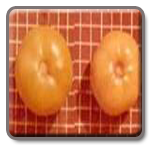 |
CO 1 (1969) |
|
It is a pureline selection isolated from American variety "Pearl Harbour". The crop duration is 135 days. The crop adapts to tropical plains of Tamil Nadu with a yield potential of 35 tonnes of fruits per hectare. It is a semi determinate variety. The plants are dwarf, semi-spreading and need no staking. The leaves are potato leaved type and lightly pubescent. The plants come to flowering in 50-55 days. Each plant-bears, on an average of 55 fruits. The fruits are nearly round and smooth. The fruits are pale green in color when unripe and attractive capsicum red when ripe. The fruits are susceptible to cracking. The seed content of the fruits is less and the proportion of flesh to seed content is very high. The fruits contain 0.69% acidity, 17.50 mg per100g of ascorbic acid and 2.74% of reducing sugars. |
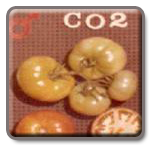 |
CO 2 (1974) |
|
It is a selection from a Russian introduction. The crop duration is 145 days, and yields to a maximum of 41.0 tonnes of fruits per hectare. The plants are semidwarf with erect habit and need no staking. The first harvest of fruits can be had in 100 days after sowing and be continued up to 145 days with 8 harvests. The fruits are smooth, medium sized (100 to120 g), flat with 4 -5 furrows, green color when unripe and reaching capsicum red after ripening. Fruits are borne in clusters of 4 to 5, yielding 20-25 fruits per plant, weighing 2.8 to 3.8 kg. The seed content is moderate (0.65%) and 167 kg of fruits give one kg of seed.
The desirable feature of this variety is that its fruits are devoid of cracking which is helpful to stand transport better. The fruit is fleshy with 65 per cent of pulp. Nutritionally the fruits are superior with a higher ascorbic acid content of 19.5 mg of 100g juice, which is two times higher than CO.1. |
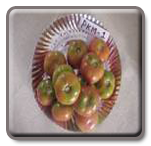 |
PKM 1 (1978) |
|
It is another induced mutant from a local variety called Annanji and yields on an average, 32 t/ha in a duration of 135 days. The plants are determinate. The fruits are flat round attractive with capiscum red color with prominent green shoulders even after ripening. Fruits are uniform in shape, firm and ideally suitable for long distance transport. The TSS content of fruit is 3.6°brix and acidity is 0.99%. The fruits contain 23.7 mg vitamin C per 100g of fruit pulp. |
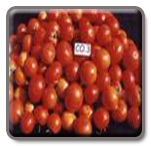 |
CO3 (1980) |
|
Co.3 (Marutham) was evolved through induced mutation by treating the seed of CO.1 tomato (IM 39) with EMS. Plants are compact, less spreading, dwarf, and determinate. It lends itself for high density planting with a spacing of 60 x 30 cm. Fruits are borne in clusters of 4 to 5. Fruit is round globular, smooth, medium sized-and attractive weighing 45to 50 g and are rich in vitamin C (25 mg/100g), TSS (3.2obrix) and acidity (3.8 per cent). Fruits are parrot green in color when unripe and reach capsicum red on ripening. Each plant yields 30-40 fruits. Flesh to seed ratio is 167:1. Plants flower in 50-55 days after sowing and first harvest can be done in another 30 days. The total crop duration is only 100 to 105 days and capable of yielding as high as 45 tonnes of fruits per hectare and it performs well during summer season. |
Paiyur 1 (1988) |
It is a hybrid derivative of a cross between Pusa Ruby and Co.3 (Marutham). It is early in flowering (20-25 days from transplanting) with an extended harvest period of 10-12 pickings. It yields about 30 tonnes per hectare. The fruits are round, medium sized, slight ribbing at calyx end and with medium firmness ensuring keeping quality and suitable for distant transport. This variety has low incidence of fruit borer (Heliothis armigera) and diseases like leaf spot and leaf curl virus. It is suitable for cultivation in the rainfed tomato growing areas of Salem and Dharmapuri districts. |
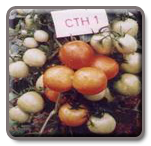 |
COTH 1 (1998) |
|
It is a hybrid developed by crossing IHR 709 X LE.812 and released from the Horticultural College and Research Institute, Coimbatore. The hybrid has duration of 115 days in the main field after transplanting. The season of sowing is May-June and November–December. The fruits are medium sized (50 g/fruit), bright red in color and borne in clusters of 4-5. The fruits are acidic (0.61%) with a TSS of 4.43° brix. The hybrid yields 95.9 t/ha of fruits, which is 11% more over Rashmi. The plants need staking with wooden sticks. This hybrid is adapted to Coimbatore, Dharmapuri, Madurai, Dindigul, Theni, Cuddalore, Villupuram, Pudukottai, Erode and Kanyakumari districts. |
 |
COLCRH 3 (2006) |
|
It is hybrid developed from LCR 2 / CLN 2123 A and released from Horticulture College and Research Institute, Coimbatore. Plants are semi determinate (80-85 cm) and suitable for high density planting. Fruits are smooth round to slightly oblong, medium sized, unripe fruits whitish green, ripe fruits bright red coloured and borne in clusters of 3-5 fruits (fruit weight 65-70 g). Plants are resistant to leaf curl virus disease. It is high yielding and suitable for cultivation without pesticide spray. This variety can be cultivated during May-June, Nov.-Dec. and Feb.-Mar with a duration of 140 -145 days. It is having a yield potential of 90.20 t/ha which is 22.40 % increase over COTH 1 and 27.90 % over Lakshmi hybrid. This variety is suitable for cultivation in Coimbatore, Dharmapuri, Salem, Madurai, Namakkal, Thiruvannamalai, Tirunelveli, Thoothukudi, Trichy, Virudhunagar, Villupuram and Erode districts under irrigated condition. |
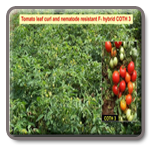 |
COTH 3 |
|
- F1 hybrid developed by crossing HN2xCLN 2123A
- Plants semi determinate and suitable for high density planting
- Fruits round, medium sized and borne in clusters of 3-5
- Good fruit quality with TSS of 5.580
- Moderately resistant to leaf curl virus disease and root knot nematodebrix, titrable acidity of 0.73% and ascorbic acid content of 35.72 mg/100g
- Duration - 145-150 days
- Yield - 96.2 t/ha
|
| Top |
| 37. Watermelon |
 |
PKM 1 (1993) |
|
It is a selection from a local type. The skin is dark green with attractive pink flesh. Fruits are bigger in size with dark green skin and pinkish red flesh. Each fruit weighs 3-4 kg. It produces flowers only. By 10-15 days with a favourable flower sex ratio of 1 male: 16 female. The crop duration is 120 to 135 days. The season for cultivation is June-October and December-April. It yields 36-38 t/ha. The variety is suited to tropical plains of Tamil Nadu. |
| Top |
|
|

